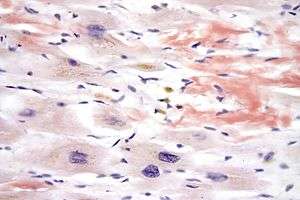Restrictive cardiomyopathy
| Restrictive cardiomyopathy | |
|---|---|
| Synonyms | Obliterative cardiomyopathy, infiltrative cardiomyopathy, constrictive cardiomyopathy[1] |
 | |
| Micrograph of cardiac amyloidosis, a cause of restrictive cardiomyopathy. Congo red stain. | |
| Classification and external resources | |
| Specialty | cardiology |
| ICD-10 | I42.5 |
| ICD-9-CM | 425.4 |
| DiseasesDB | 11390 |
| MedlinePlus | 000189 |
| eMedicine | med/291 |
| MeSH | D002313 |
Restrictive cardiomyopathy (RCM) is a form of cardiomyopathy in which the walls are rigid,[2] and the heart is restricted from stretching and filling with blood properly. It is the least common of John Forrest Goodwin's three original subtypes of cardiomyopathy, which includes hypertrophic and dilated as well as restrictive.[1]
It should not be confused with constrictive pericarditis, a disease which presents similarly but is very different in treatment and prognosis.[1]

Signs and symptoms
Rhythmicity and contractility of the heart may be normal, but the stiff walls of the heart chambers (atria and ventricles) keep them from adequately filling, reducing preload and end-diastolic volume.
Thus, blood flow is reduced, and blood volume that would normally enter the heart is backed up in the circulatory system. In time, restrictive cardiomyopathy patients develop diastolic dysfunction and eventually heart failure.
Untreated hearts with RCM often develop the following characteristics: Biatrial enlargement, thickened LV walls (with normal chamber size), thickened RV free wall (with normal chamber size), elevated right atrial pressure (>12mmHg), moderate pulmonary hypertension, normal systolic function, poor diastolic function, typically Grade III - IV Diastolic heart failure.
Causes
It is possible to divide the causes into primary and secondary.[3]
Primary
Secondary
- infiltrative
- interstitial
- post radiation therapy fibrosis
Other causes include scleroderma, eosinophilic granulomatosis with polyangiitis, cystinosis, lymphoma, Gaucher's disease, Fabry's disease, pseudoxanthoma elasticum, hypereosinophilic syndrome, carcinoid, Noonan's syndrome, reactive arthritis, and Werner's syndrome.[4]
Treatment
Treatment of restrictive cardiomyopathy should focus on management of causative conditions (for example, using corticosteroids if the cause is sarcoidosis), and slowing the progression of cardiomyopathy. Diuretics, vasodilators, angiotensin-converting enzyme inhibitors, and anticoagulation may be indicated for managing restrictive cardiomyopathy.[5]
Calcium channel blockers are generally contraindicated due to their negative inotropic effect, particularly in cardiomyopathy caused by amyloidosis.[6][7] Digoxin, calcium channel blocking drugs and beta-adrenergic blocking agents provide little benefit, except in the subgroup of restrictive cardiomyopathy with atrial fibrillation.[8]
Heart failure resulting from restrictive cardiomyopathy will usually eventually have to be treated by cardiac transplantation or left ventricular assist device.[5]
References
- 1 2 3 Hancock, EW (September 2001). "Differential diagnosis of restrictive cardiomyopathy and constrictive pericarditis". Heart (British Cardiac Society). 86 (3): 343–9. PMC 1729880
 . PMID 11514495. Retrieved 15 October 2011.
. PMID 11514495. Retrieved 15 October 2011. - ↑ "restrictive cardiomyopathy" at Dorland's Medical Dictionary
- ↑ Crawford, Michael H. (2003). Current diagnosis & treatment in cardiology. New York: Lange Medical Books/McGraw-Hill. p. 188. ISBN 0-8385-1473-1.
- ↑ Stöllberger, C.; Finsterer, J. (2007). "Extracardiac medical and neuromuscular implications in restrictive cardiomyopathy". Clinical Cardiology. 30 (8): 375–380. doi:10.1002/clc.20005. PMID 17680617.
- 1 2 "Restrictive Cardiomyopathy Treatment & Management". 2014-12-18. Retrieved 2015-06-10.
- ↑ Pollak, A; Falk, R H (1993-08-01). "Left ventricular systolic dysfunction precipitated by verapamil in cardiac amyloidosis.". Chest. 104 (2): 618–620. doi:10.1378/chest.104.2.618. ISSN 0012-3692. Retrieved 2015-06-10.
- ↑ Gertz, Morie A.; Falk, Rodney H.; Skinner, Martha; Cohen, Alan S.; Kyle, Robert A. (1985-06-01). "Worsening of congestive heart failure in amyloid heart disease treated by calcium channel-blocking agents". American Journal of Cardiology. 55 (13): 1645. doi:10.1016/0002-9149(85)90995-6. ISSN 0002-9149. PMID 4003314. Retrieved 2015-06-10.
- ↑ Artz, Gregory; Wynne, Joshua (October 2000). "Restrictive Cardiomyopathy". Current Treatment Options in Cardiovascular Medicine. 2 (5): 431–438. doi:10.1007/s11936-000-0038-6. ISSN 1092-8464. PMID 11096547.